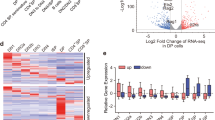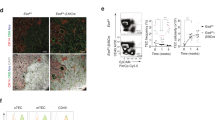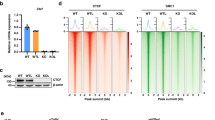Abstract
Coreceptor expression is tightly regulated during thymocyte development. Deletion of specific Cd8 enhancers leads to variegated expression of CD8αβ heterodimers in double-positive thymocytes. Here we show CD8 variegation is correlated with an epigenetic 'off' state, linking Cd8 enhancer function with chromatin remodeling of the adjacent genes Cd8a and Cd8b1 (Cd8). The zinc finger protein MAZR bound the Cd8 enhancer and interacted with the nuclear receptor corepressor N-CoR complex in double-negative thymocytes. MAZR was downregulated in double-positive and CD8 single-positive thymocytes. 'Enforced' expression of MAZR led to impaired Cd8 activation and variegated CD8 expression. Our results demonstrate epigenetic control of the Cd8 loci and identify MAZR as an important regulator of Cd8 expression.
This is a preview of subscription content, access via your institution
Access options
Subscribe to this journal
Receive 12 print issues and online access
$209.00 per year
only $17.42 per issue
Buy this article
- Purchase on Springer Link
- Instant access to full article PDF
Prices may be subject to local taxes which are calculated during checkout








Similar content being viewed by others
References
Fisher, A.G. Cellular identity and lineage choice. Nat. Rev. Immunol. 2, 977–982 (2002).
Ansel, K.M., Lee, D.U. & Rao, A. An epigenetic view of helper T cell differentiation. Nat. Immunol. 4, 616–623 (2003).
Smale, S.T. The establishment and maintenance of lymphocyte identity through gene silencing. Nat. Immunol. 4, 607–615 (2003).
Taniuchi, I., Ellmeier, W. & Littman, D.R. The CD4/CD8 lineage choice: new insights into epigenetic regulation during T cell development. Adv. Immunol. 83, 55–89 (2004).
Sawada, S. & Littman, D.R. Identification and characterization of a T-cell-specific enhancer adjacent to the murine Cd4 gene. Mol. Cell. Biol. 11, 5506–5515 (1991).
Donda, A., Schulz, M., Burki, K., De Libero, G. & Uematsu, Y. Identification and characterization of a human CD4 silencer. Eur. J. Immunol. 26, 493–500 (1996).
Sawada, S., Scarborough, J.D., Killeen, N. & Littman, D.R. A lineage-specific transcriptional silencer regulates Cd4 gene expression during T lymphocyte development. Cell 77, 917–929 (1994).
Siu, G., Wurster, A.L., Duncan, D.D., Soliman, T.M. & Hedrick, S.M. A transcriptional silencer controls the developmental expression of the CD4 gene. EMBO J. 13, 3570–3579 (1994).
Zou, Y.R. et al. Epigenetic silencing of CD4 in T cells committed to the cytotoxic lineage. Nat. Genet. 29, 332–336 (2001).
Leung, R.K. et al. Deletion of the Cd4 silencer element supports a stochastic mechanism of thymocyte lineage commitment. Nat. Immunol. 2, 1167–1173 (2001).
Kioussis, D. & Ellmeier, W. Chromatin and CD4, CD8A and CD8B gene expression during thymic differentiation. Nat. Rev. Immunol. 2, 909–919 (2002).
Ellmeier, W., Sunshine, M.J., Losos, K. & Littman, D.R. Multiple developmental stage-specific enhancers regulate CD8 expression in developing thymocytes and in thymus-independent T cells. Immunity 9, 485–496 (1998).
Hostert, A. et al. Hierarchical interactions of control elements determine CD8α gene expression in subsets of thymocytes and peripheral T cells. Immunity 9, 497–508 (1998).
Ellmeier, W., Sunshine, M.J., Maschek, R. & Littman, D.R. Combined deletion of CD8 locus cis-regulatory elements affects initiation but not maintenance of CD8 expression. Immunity 16, 623–634 (2002).
Garefalaki, A. et al. Variegated expression of CD8α resulting from in situ deletion of regulatory sequences. Immunity 16, 635–647 (2002).
Harker, N. et al. The CD8A gene locus is regulated by the Ikaros family of proteins. Mol. Cell 10, 1403–1415 (2002).
Feik, N. et al. Functional and molecular analysis of the double-positive stage-specific CD8 enhancer E8III during thymocyte development. J. Immunol. 174, 1513–1524 (2005).
Chi, T.H. et al. Reciprocal regulation of CD4/CD8 expression by SWI/SNF-like BAF complexes. Nature 418, 195–199 (2002).
Lee, P.P. et al. A critical role for Dnmt1 and DNA methylation in T cell development, function, and survival. Immunity 15, 763–774 (2001).
Kobayashi, A. et al. A combinatorial code for gene expression generated by transcription factor Bach2 and MAZR (MAZ-related factor) through the BTB/POZ domain. Mol. Cell. Biol. 20, 1733–1746 (2000).
Bernstein, B.E. et al. Genomic maps and comparative analysis of histone modifications in human and mouse. Cell 120, 169–181 (2005).
Jenuwein, T. & Allis, C.D. Translating the histone code. Science 293, 1074–1080 (2001).
Carbone, A.M., Marrack, P. & Kappler, J.W. Demethylated Cd8 gene in CD4+ T cells suggests that CD4+ cells develop from CD8+ precursors. Science 242, 1174–1176 (1988).
Hamerman, J.A., Page, S.T. & Pullen, A.M. Distinct methylation states of the Cd8b gene in peripheral T cells and intraepithelial lymphocytes. J. Immunol. 159, 1240–1246 (1997).
van Meerwijk, J.P. & Germain, R.N. Development of mature CD8+ thymocytes: selection rather than instruction? Science 261, 911–915 (1993).
He, X. et al. The zinc finger transcription factor Th-POK regulates CD4 versus CD8 T-cell lineage commitment. Nature 433, 826–833 (2005).
Sun, G. et al. The zinc finger protein cKrox directs CD4 lineage differentiation during intrathymic T cell positive selection. Nat. Immunol. 6, 373–381 (2005).
Huynh, K.D. & Bardwell, V.J. The BCL-6 POZ domain and other POZ domains interact with the co-repressors N-CoR and SMRT. Oncogene 17, 2473–2484 (1998).
Polo, J.M. et al. Specific peptide interference reveals BCL6 transcriptional and oncogenic mechanisms in B-cell lymphoma cells. Nat. Med. 10, 1329–1335 (2004).
Yoon, H.G., Chan, D.W., Reynolds, A.B., Qin, J. & Wong, J. N-CoR mediates DNA methylation-dependent repression through a methyl CpG binding protein Kaiso. Mol. Cell 12, 723–734 (2003).
Melnick, A. et al. Critical residues within the BTB domain of PLZF and Bcl-6 modulate interaction with corepressors. Mol. Cell. Biol. 22, 1804–1818 (2002).
Sato, T. et al. Dual functions of Runx proteins for reactivating CD8 and silencing CD4 at the commitment process into CD8 thymocytes. Immunity 22, 317–328 (2005).
Jepsen, K. & Rosenfeld, M.G. Biological roles and mechanistic actions of co-repressor complexes. J. Cell Sci. 115, 689–698 (2002).
Jepsen, K. et al. Combinatorial roles of the nuclear receptor corepressor in transcription and development. Cell 102, 753–763 (2000).
Wack, A., Coles, M., Norton, T., Hostert, A. & Kioussis, D. Early onset of CD8 transgene expression inhibits the transition from DN3 to DP thymocytes. J. Immunol. 165, 1236–1242 (2000).
Pear, W.S. et al. Efficient and rapid induction of a chronic myelogenous leukemia-like myeloproliferative disease in mice receiving P210 bcr/abl-transduced bone marrow. Blood 92, 3780–3792 (1998).
Schreiber, E., Matthias, P., Muller, M.M. & Schaffner, W. Rapid detection of octamer binding proteins with 'mini-extracts', prepared from a small number of cells. Nucleic Acids Res. 17, 6419 (1989).
Ausubel, F.M. et al. Current Protocols in Molecular Biology Ch. 10 (Greene Publishing Associates–Wiley Interscience, New York, 1992).
Hostert, A. et al. A CD8 genomic fragment that directs subset-specific expression of CD8 in transgenic mice. J. Immunol. 158, 4270–4281 (1997).
Gorman, S.D., Sun, Y.H., Zamoyska, R. & Parnes, J.R. Molecular linkage of the Ly-3 and Ly-2 genes. Requirement of Ly-2 for Ly-3 surface expression. J. Immunol. 140, 3646–3653 (1988).
Acknowledgements
We thank V.J. Bardwell for N-CoR expression constructs; E. Pfeiffer and E. Selzev for help with irradiation; and S. Sakaguchi, P. Kinross and R. Herbst for critical reading of the manuscript. Supported by the Austrian Science Fund (P14261 and P16708), the START Program (Project Y-163) of the Austrian Ministry of Education, Science and Culture, the K-plus Competence Center Biomolecular Therapeutics, the Federal Bank of Austria (Project 10530), the Austrian Program for Advanced Research and Technology of the Austrian Academy of Sciences (W.E.) and the National Institutes of Health (HD39454 and HD18184 to C.B.W.).
Author information
Authors and Affiliations
Corresponding author
Ethics declarations
Competing interests
The authors declare no competing financial interests.
Supplementary information
Supplementary Fig. 1
Loss of Dnmt1 leads to a partial reactivation of CD8 expression in variegated DP cells. (PDF 80 kb)
Supplementary Fig. 2
Map of the clone isolated in the YOH screen and localization of the bait RE-1 sequence. (PDF 123 kb)
Supplementary Fig. 3
Specificity of the anti-MAZR serum. (PDF 84 kb)
Supplementary Fig. 4
Retroviral constructs used for the transduction of hematopoietic stem cells. (PDF 95 kb)
Supplementary Fig. 5
CD8-negative DP thymocytes develop upon forced expression of MAZR in Tcra/ thymocytes. (PDF 140 kb)
Supplementary Table 1
PCR primers used for bisulfite sequencing analysis. (PDF 12 kb)
Supplementary Table 2
PCR primers used for ChIP assays. (PDF 16 kb)
Rights and permissions
About this article
Cite this article
Bilic, I., Koesters, C., Unger, B. et al. Negative regulation of CD8 expression via Cd8 enhancer–mediated recruitment of the zinc finger protein MAZR. Nat Immunol 7, 392–400 (2006). https://doi.org/10.1038/ni1311
Received:
Accepted:
Published:
Issue Date:
DOI: https://doi.org/10.1038/ni1311
This article is cited by
-
The zinc-finger transcription factor MAZR regulates iNKT cell subset differentiation
Cellular and Molecular Life Sciences (2019)
-
The corepressor NCOR1 regulates the survival of single-positive thymocytes
Scientific Reports (2017)
-
The transcription factor Zbtb32 controls the proliferative burst of virus-specific natural killer cells responding to infection
Nature Immunology (2014)
-
Epigenetic plasticity of Cd8a locus during CD8+ T-cell development and effector differentiation and reprogramming
Nature Communications (2014)
-
PATZ1 interacts with p53 and regulates expression of p53-target genes enhancing apoptosis or cell survival based on the cellular context
Cell Death & Disease (2013)



